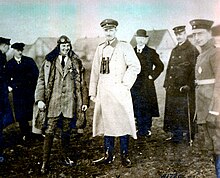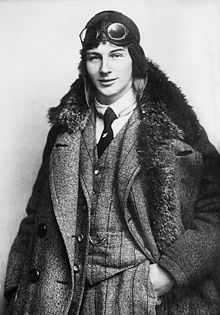Anton Herman Gerard Fokker
Anton Herman Gerard "Anthony" Fokker (born April 6, 1890 in Kediri on Java ; † December 23, 1939 in New York ) was a Dutch-German-American aircraft manufacturer .
Life
His father Herman Fokker, owner of a coffee plantation on Java, returned with the family to Haarlem in the Netherlands in 1894 . The twenty-year-old Fokker was supposed to attend an automobile construction course at the engineering school in Bingen in Germany in 1910 , but he enrolled in an aircraft construction course in Zahlbach near Mainz . During his studies, he used the money of his father and his colleague, Lieutenant Franz von Daum, to build an aircraft according to his ideas at Goedecker Flugmaschinenwerke , the "Fokker Spider". On June 7, 1911, he acquired the pilot's license ( flight license ) No. 88 of the German Aviation Association (DLV) according to the regulations of the Fédération Aéronautique Internationale (FAI) on this machine and is thus an old eagle .
After founding his aircraft factory "AHG Fokker Aeroplanbau" in Berlin-Johannisthal in February 1912, Fokker built around 25 M.1 (Spider) aircraft . The individual parts were supplied by Goedecker and assembled at Fokker. The young entrepreneur, suffering from constant financial difficulties, tried not only to train pilots, but also to receive military contracts and took part in design competitions.
In mid-1913, Fokker relocated his aircraft factory from Berlin to Schwerin , and in May he had already opened a flight school at the Schwerin-Görries airfield. In his factory, built from October 1913 in today's Schwerin Bornhövedstraße, he mainly manufactured fighter aircraft that were used in the First World War . At the beginning of 1914 the company was renamed "Fokker Aeroplanbau GmbH", Fokker received its first military contracts and the company recovered financially.
The upswing of the aircraft works began with the outbreak of the war in August 1914, when army and navy officers appeared almost every day at Fokker, who bought all the existing aircraft and engines and commissioned new ones. In order to guarantee production, the Fokker factories expanded. New barracks and halls were constantly being built in Bornhövedstrasse and on the airfield. In Schwerin he bought into the Perzina piano factory in order to have wood specialists. Further branches were added, for example the Adolf Nutzmann piano factory in Schwerin, the Zimmermann weapons factory in Berlin-Reinickendorf , and in 1916 he acquired a sixth of the shares in the Oberursel AG engine factory , with whose rotary engines most of his fighter planes were equipped, and Magyar Általános Gépgyár in Hungary ; in October 1917 he became a co-owner of the Lübeck-Travemünde GmbH aircraft yard . The number of Fokker employees increased during the war from approx. 100 to approx. 6000, of which he employed 1800 in Schwerin alone. In 1915, on his 25th birthday, Anton Fokker received German citizenship on the instructions of the Supreme Army Command .

He first achieved fame when, in April 1915, he allegedly developed a synchronization mechanism within two days that made it possible to fire a machine gun through the propeller circle without damaging the propeller blades. In fact, however, this invention was apparently made by Heinrich Lübbe and Kurt Heber , both of whom worked in the Fokkers weapons department. The Fokker EI monoplane was the first German aircraft with this revolutionary mechanism. This development gave the German aviators about half a year of air superiority. For this invention, Fokker was awarded the Iron Cross by the German Emperor . The inventor Franz Schneider sued Fokker after the war for "patent theft", but Fokker knew how to delay all processes and, despite conviction, paid nothing. It also turned out that Schneider's patent would have failed in reality.
In its day, Fokker was probably the only aircraft manufacturer who spoke personally to the pilots at the front to hear their opinions and wishes. Many later known fighter pilots from the First World War, including Manfred von Richthofen , Max Immelmann and Oswald Boelcke , used aircraft from Fokker. Werner Voss , for example, scored 22 kills with the prototype (Fokker FI 103/17) of within three weeks Fokker Dr.I . By order of the Supreme Army Command , Fokker worked with Hugo Junkers from 1917 to 1919 . But the two aircraft manufacturers pursued fundamentally different directions in aircraft construction. Except for a few test monoplane, there was no fruitful collaboration.

In the Treaty of Versailles Germany was banned after World War II, the construction of aircraft and aircraft engines. Due to these restrictions, in 1919, with a sophisticated plan, Fokker relocated its Schwerin factory by rail to Veere in the Netherlands within six weeks. In Amsterdam, with the help of an uncle and other donors, he founded the N.V. Koninklijke Nederlandse Vocityuigenfabriek Fokker . In the same year, Fokker married Elisabeth von Morgen, the daughter of the German general Curt von Morgen . After four years the marriage was divorced again.
In 1922, Fokker emigrated to the United States and founded the Fokker Aircraft Corporation there . In the United States, he also met his second wife, Violet Eastman, who committed suicide on February 8, 1929. Both of Fokker's marriages remained childless. In 1926, US law stipulated that companies that sold aircraft to the armed forces had to be American-owned, and Fokker took American citizenship. In 1929 General Motors (GM) held a 40 percent stake in Fokker's company to keep up with competitor Ford . After the stock market crash of 1929 , orders were canceled and the company posted losses. General Motors increased the share to 50 percent, while Fokker still controlled 20 percent of "his" company. He was also deposed as chief engineer. In 1931 a Fokker F.10 had an accident on Transcontinental and Western Air Flight 5 , killing the famous football coach Knute Rockne . As a result, these aircraft were banned from flying. In 1931 GM stopped working with Fokker and GM closed all remaining Fokker factories. Thanks to his contacts, however, Fokker became an agent for the marketing of Douglas and Lockheed aircraft in Europe.
Fokker's autobiography The Flying Dutchman was also published in German in 1933. At the beginning of the 1930s, Fokker withdrew more and more from business life. On December 23, 1939, Anton Herman Gerard Fokker died in New York at the age of 49 after a surgical operation from the consequences of an infection of the surgical wound and meningitis .
literature
- Marc Dierikx: Dwarswind. A biography of Anthony Fokker. Sdu Uitgevers, The Hague 1997.
- Marc Dierikx: Anthony Fokker. Een vervlogen leven. Uitg. Boom, Amsterdam 2014.
- Michael Schmidt: Aircraft construction in Schwerin 1913–1926 . In: Mecklenburg and the First World War , Thomas-Helms-Verlag, Schwerin 2010, ISBN 978-3-940207-19-7 .
- Wilhelm Pleines: Fokker, Anthony. In: New German Biography (NDB). Volume 5, Duncker & Humblot, Berlin 1961, ISBN 3-428-00186-9 , p. 285 ( digitized version ).
- Anton Herman Gerard Fokker: The Flying Dutchman. Rascher & Cie., Zurich / Leipzig / Stuttgart 1933.
- Anthony Fokker and Bruce Gould: Flying Dutchman. Penguin Books, Harmondsworth 1938.
- Volker Koos: The Fokker aircraft works in Schwerin. Reinhard Thon, Schwerin 1993. ISBN 3-928820-21-4 .
- Horst Zänger: How aircraft construction came to Schwerin. In: Mecklenburg , home magazine for compatriots. Stock & Stein, Schwerin 46.2004, 11, pp. 14–15.
- Henri Hegener: The Man and the Aircraft. Harleyford Publications Ltd. 1961.
Web links
- Newspaper article about Anton Herman Gerard Fokker in the press kit 20th Century of the ZBW - Leibniz Information Center for Economics .
Individual evidence
- ↑ Helmut Hujer: 125 years of Motorenfabrik Oberursel - 1892 to 2017. Self-published by Helmut Hujer, Usingen 2017
- ↑ Hans Krabbendam, Cornelis A. van Minnen, Giles Scott-Smith: Four Centuries of Dutch-American Relations: 1609-2009 , Suny Press, 2009, ISBN 978-1-4384-3013-3 ; Page 546.
| personal data | |
|---|---|
| SURNAME | Fokker, Anton Herman Gerard |
| ALTERNATIVE NAMES | Fokker, Anthony |
| BRIEF DESCRIPTION | Dutch aircraft manufacturer |
| DATE OF BIRTH | April 6, 1890 |
| PLACE OF BIRTH | Kediri |
| DATE OF DEATH | December 23, 1939 |
| Place of death | New York City |




